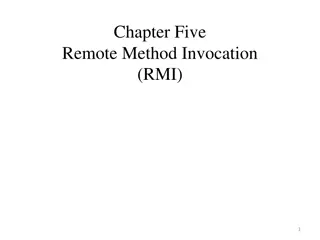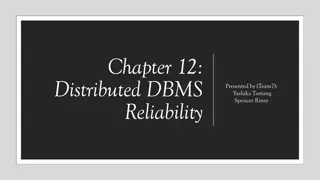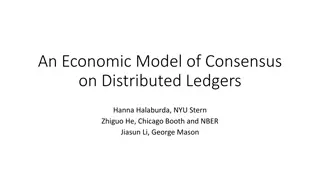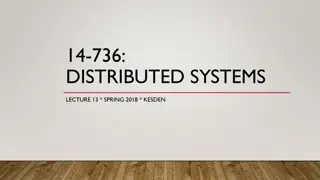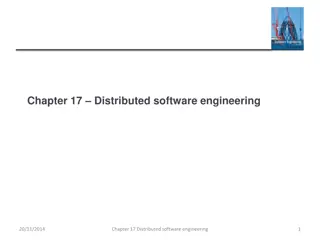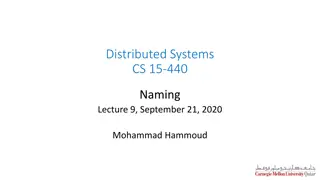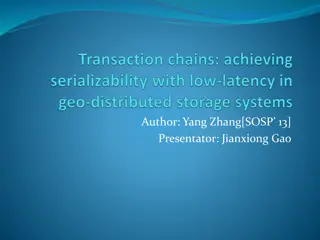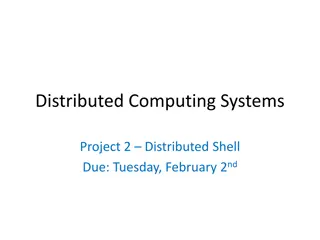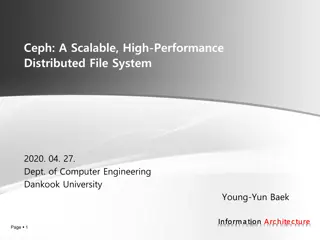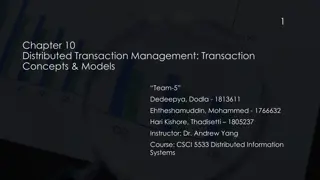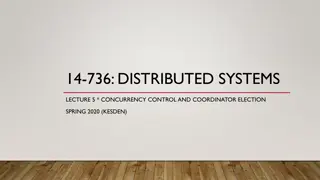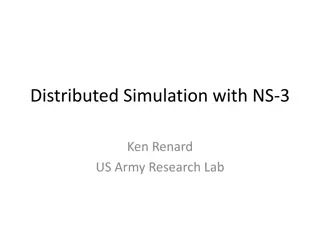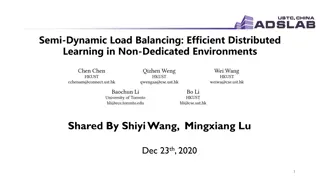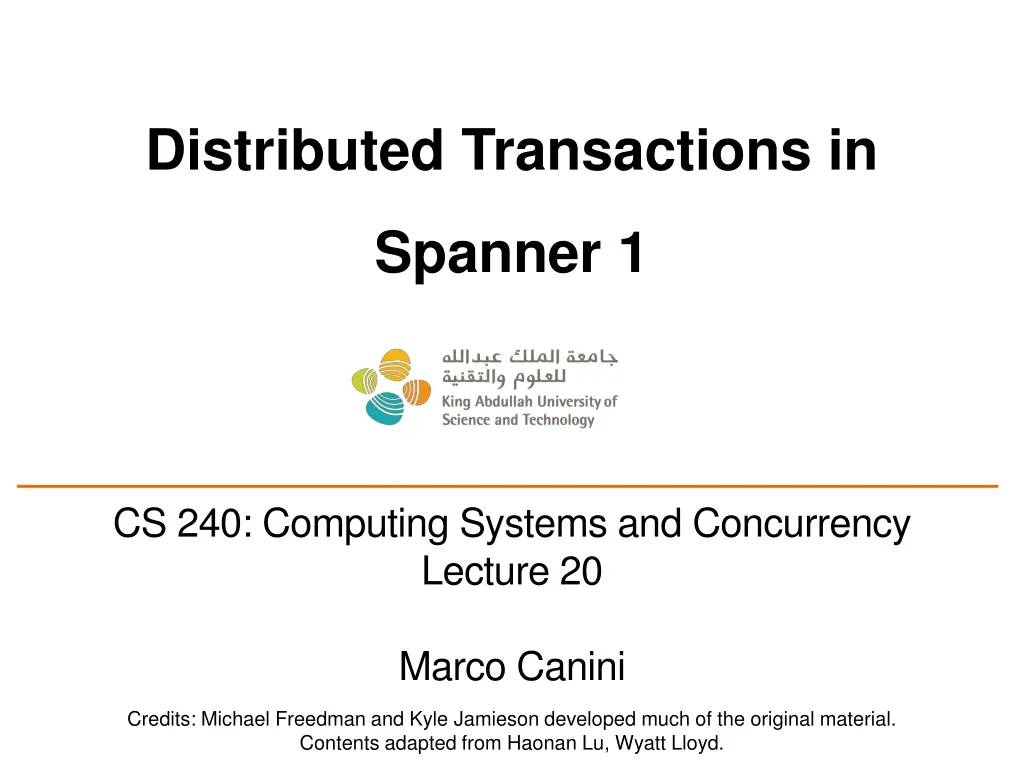
Understanding Distributed Transactions in Spanner
Explore the concept of distributed transactions in Spanner, covering topics such as concurrency control, replication, and Google's motivation for building Spanner. Learn about the tradeoff between performance and consistency, read-only transactions, and the challenges of designing a strictly serializable, geo-replicated system.
Download Presentation

Please find below an Image/Link to download the presentation.
The content on the website is provided AS IS for your information and personal use only. It may not be sold, licensed, or shared on other websites without obtaining consent from the author. If you encounter any issues during the download, it is possible that the publisher has removed the file from their server.
You are allowed to download the files provided on this website for personal or commercial use, subject to the condition that they are used lawfully. All files are the property of their respective owners.
The content on the website is provided AS IS for your information and personal use only. It may not be sold, licensed, or shared on other websites without obtaining consent from the author.
E N D
Presentation Transcript
Distributed Transactions in Spanner 1 CS 240: Computing Systems and Concurrency Lecture 20 Marco Canini Credits: Michael Freedman and Kyle Jamieson developed much of the original material. Contents adapted from Haonan Lu, Wyatt Lloyd.
Recap: Distributed Storage Systems Concurrency control Order transactions across shards State machine replication Replicas of a shard apply transactions in the same order decided by concurrency control 2
Googles Setting Dozens of zones (datacenters) Per zone, 100-1000s of servers Per server, 100-1000 partitions (tablets) Every tablet replicated for fault-tolerance (e.g., 5x) 3
Why Google built Spanner 2005 BigTable [OSDI 2006] Eventually consistent across datacenters Lesson: don t need distributed transactions 2008? MegaStore [CIDR 2011] Strongly consistent across datacenters Option for distributed transactions Performance was not great 2011 Spanner [OSDI 2012] Strictly Serializable Distributed Transactions We wanted to make it easy for developers to build their applications 4
A Deeper Look at Motivation -- Performance-consistency tradeoff Strict serializability Serializability + linearizability As if coding on a single-threaded, transactionally isolated machine Spanner calls it external consistency Strict serializability makes building correct application easier Strict serializability is expensive Performance penalty in concurrency control + Replication OCC/2PL: multiple round trips, locking, etc.
A Deeper Look at Motivation -- Read-Only Transactions Transactions that only read data Predeclared, i.e., developer uses READ_ONLY flag / interface Reads dominate real-world workloads FB s TAO had 500 reads : 1 write [ATC 2013] Google Ads (F1) on Spanner from 1? DC in 24h: 31.2 M single-shard read-write transactions 32.1 M multi-shard read-write transactions 21.5 B read-only (~340 times more) Determines system overall performance
Can we design a strictly serializable, geo-replicated, sharded system with very fast (efficient) read-only transactions? 7
Before we get to Spanner How would you design SS read-only transactions? OCC or 2PL Multiple round trips and locking Can always read in local datacenters like COPS? Maybe involved in Paxos agreement Or must contact the leader Performance penalties Round trips increase latency, especially in wide area Distributed lock management is costly, e.g., deadlocks 8
Goal is to Make read-only transactions efficient One round trip Could be wide-area Lock-free No deadlocks Processing reads do not block writes, e.g., long-lived reads Always succeed Do not abort And strictly serializable
Leveraging the Notion of Time Strict serializability: a matter of real-time ordering If txn T2 starts after T1 finishes, then T2 must be ordered after T1 If T2 is a ro-txn, then T2 should see the effects of all writes that finished before T2 started
Leveraging the Notion of Time Task 1: when committing a write, tag it with the current physical time Task 2: when reading the system, check which writes were committed before the time this read started How about the serializable requirement? Physical time naturally gives a total order
Invariant: If T2 starts after T1 commits (finishes), then T2 must have a larger timestamp Trivially provided by perfect clocks 12
Challenges Clocks are not perfect Clock skew: some clocks are faster/slower Clock skew may not be bounded Clock skew may not be known a priori T2 may be tagged with a smaller timestamp than T1 due to T2 s slower clock Seems impossible to have perfect clocks in distributed systems. What can we do?
Nearly perfect clocks Partially synchronized Clock skew is bounded and known a priori My clock shows 1:30PM, then I know the absolute (real) time is in the range of 1:30 PM +/- X e.g., between 1:20PM and 1:40PM if X = 10 mins Clock skew is short E.g., X = a few milliseconds Enable something special, e.g., Spanner!
Spanner: Googles Globally- Distributed Database OSDI 2012 15
Scale-out vs. fault tolerance O OO P PP QQQ Every tablet replicated via MultiPaxos So every operation within transactions across tablets actually is a replicated operation within Paxos RSM Paxos groups can stretch across datacenters! 16
Strictly Serializable Multi-Shard Transactions How are clocks made nearly perfect ? How does Spanner leverage these clocks? How are writes done and tagged? How read-only transactions are made efficient?
TrueTime (TT) Global wall-clock time with bounded uncertainty is worst-case clock divergence Spanner s time notion becomes intervals, not single values is 4ms on average, 2 is about 10ms TT.now() time earliest latest 2* Consider event enow which invoked tt = TT.now(): Guarantee: tt.earliest <= tabs(enow) <= tt.latest 18
TrueTime (TT) Interface TT.now() = [earliest, latest] # latest earliest = 2* TT.after(t) = true if t has passed TT.now().earliest > t (b/c tabs >= TT.now().earliest) TT.before(t) = true if t has not arrived TT.now().latest < t (b/c tabs <= TT.now().latest) Implementation Relies on specialized hardware, e.g., GPS satellite and atomic clocks 19
TrueTime Architecture GPS GPS GPS timemaster timemaster timemaster GPS Atomic-clock timemaster GPS timemaster timemaster Client Datacenter 1 Datacenter 2 Datacenter n Compute reference [earliest, latest] = now 20
TrueTime implementation now = reference now + local-clock offset = reference = 1ms + worst-case local-clock drift + 200 s/sec +6ms time 0sec 30sec 60sec 90sec What about faulty clocks? Bad CPUs 6x more likely in 1 year of empirical data 21
Enforcing the Invariant If T2 starts after T1 commits (finishes), then T2 must have a larger timestamp Let T1 write SB and T2 write SA SA 5 Tabs SB T1.now() = 5 Perfect Clocks 22
Enforcing the Invariant If T2 starts after T1 commits (finishes), then T2 must have a larger timestamp Let T1 write SB and T2 write SA SA 5 8 Tabs SB T1.now() = 5 T1.commit (ts = 5) Perfect Clocks 23
Enforcing the Invariant If T2 starts after T1 commits (finishes), then T2 must have a larger timestamp T2.now() = 10 Let T1 write SB and T2 write SA SA 5 8 Tabs 10 SB T1.now() = 5 T1.commit (ts = 5) Perfect Clocks 24
Enforcing the Invariant If T2 starts after T1 commits (finishes), then T2 must have a larger timestamp T2.commit (ts = 10) T2.now() = 10 Let T1 write SB and T2 write SA SA 5 8 Tabs 15 10 SB T1.now() = 5 T1.commit (ts = 5) T2.ts > T1.ts Perfect Clocks 25
Enforcing the Invariant If T2 starts after T1 commits (finishes), then T2 must have a larger timestamp T2.commit (ts = 6) T2.now() = 6 Let T1 write SB and T2 write SA SA 5 8 Tabs 15 10 SB T1.now() = 12 T1.commit (ts = 12) T2.ts < T1.ts Imperfect Clocks 26
Enforcing the Invariant If T2 starts after T1 commits (finishes), then T2 must have a larger timestamp T2.commit (ts = 12) T2.now() = [8, 12] Let T1 write SB and T2 write SA SA 6 3 Tabs 12 15 10 8 5 SB T1.now() = [3, 6] T1.commit (ts = 6) T2.ts > T1.ts Seems working? TrueTime 27
Enforcing the Invariant If T2 starts after T1 commits (finishes), then T2 must have a larger timestamp T2.commit (ts = 12) T2.now() = [1, 12] Let T1 write SB and T2 write SA SA 3 Tabs 1 12 15 10 8 SB T1.now() = [3, 15] T1.commit (ts = 15) T2.ts < T1.ts Not working! TrueTime 28
A brain teaser puzzle We know: 1. x < y, b/c T2 in real-time after T1 (the assumption) 2. c <= y <= d, b/c TrueTime 3. T1.ts = b, T2.ts = d, b/c how ts is assigned We want: it is always true that b < d, how? 29
A brain teaser puzzle We know: 1. x < y, b/c T2 in real-time after T1 (the assumption) 2. c <= y <= d, b/c TrueTime 3. T1.ts = b, T2.ts = d, b/c how ts is assigned We want: it is always true that b < d, how? 1 and 2 x < d; we need to ensure b < x; then b < x < d, done 30
Enforcing the Invariant with TT If T2 starts after T1 commits (finishes), then T2 must have a larger timestamp Let T1 write SB and T2 write SA SA 8 3 15 Tabs SB T1.now() = [3, 15] TrueTime 31
Enforcing the Invariant with TT If T2 starts after T1 commits (finishes), then T2 must have a larger timestamp TT.after(15) == true b < x Let T1 write SB and T2 write SA SA 8 3 20 16 15 x Tabs wait SB T1.now() = [3, 15] T1.commit (ts = 15) b TrueTime 32
Enforcing the Invariant with TT If T2 starts after T1 commits (finishes), then T2 must have a larger timestamp T2.commit (ts = 22) T2.now() = [18, 22] Let T1 write SB and T2 write SA SA wait 8 3 20 16 15 Tabs 18 22 wait SB T1.now() = [3, 15] T1.commit (ts = 15) T2.ts > T1.ts TrueTime 33
Takeaways The invariant is always enforced: If T2 starts after T1 commits (finishes), then T2 must have a larger timestamp How big/small is does not matter for correctness Only need to make sure: TT.now().latest is used for ts (in this example) Commit wait, i.e., TT.after(ts) == true must be known a priori and small so commit wait is doable!
After-class Puzzles Can we use TT.now().earliest for ts? Can we use TT.now().latest 1 for ts? Can we use TT.now().latest + 1 for ts? Then what s the rule of thumb for choosing ts?



